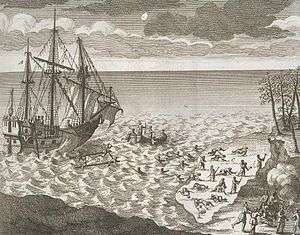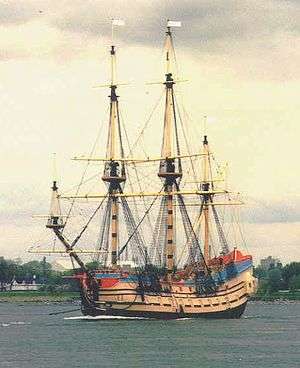Battle of Hudson's Bay
| Battle of Hudson's Bay | |||||||
|---|---|---|---|---|---|---|---|
| Part of the Nine Years' War | |||||||
 The Sinking of the Pélican, after a 1722 print by Claude-Charles Bacqueville de La Potherie | |||||||
| |||||||
| Belligerents | |||||||
|
|
| ||||||
| Commanders and leaders | |||||||
| Pierre Le Moyne d'Iberville | John Fletcher | ||||||
| Strength | |||||||
|
3 frigates
| ||||||
| Casualties and losses | |||||||
| 1 ship damaged and later lost |
1 ship sunk 1 ship captured | ||||||
The Battle of Hudson's Bay, also known as the Battle of York Factory, was a naval battle fought during the War of the Grand Alliance (known in England's North American colonies as "King William's War"). The battle took place on 5 September 1697,[1] when a French warship commanded by Captain Pierre Le Moyne d'Iberville defeated an English squadron commanded by Captain John Fletcher. As a result of this battle, the French took York Factory, a trading post of the Hudson's Bay Company. For other fighting in the region see Anglo-French conflicts on Hudson Bay.
Prelude

D'Iberville's flagship, Pélican (44-guns), was part of a larger French squadron dispatched to contest English control of Hudson Bay.[2] D'Iberville commanded Le Pélican (50 [44] cannons, captain Pierre Le Moyne d’Iberville), a 3rd rate man-of-war cut for fifty guns, and with one hundred and fifty men ship's company. Serigny commanded the Le Profond (frigate/‘storeship’) (460 t, flûte de 32 canons [+2 from Le Pélican], commanded by Pierre Du Gué, Sieur de Boisbriand.). Boisbriant commanded Le Vesp/Weesph (frigate) (Capt. Chatrie (chevalier de Chastrier) a vessel of about 300 t with about 20–26 guns). Le Palmier (frigate) (5th rate man-of-war, 300t, captain Joseph Le Moyne de Serigny) a vessel of about 20–26 guns, and originally the “Violent” renamed L'Esquimau/Esquimaux (the Eskimo), a supply ship (150 ton brigantine) Jean Outelas, Capt., capable of carrying from 10–12 guns; one report says the last was crushed by the ice pack
Before the battle, Pélican became separated from the rest of the French squadron in heavy fog, but D'Iberville elected to forge ahead. This set the stage for a little-known but spectacular single-ship action against heavy odds.[2]
As Pélican sailed south into clearer weather, she approached the trading post of York Factory, and a group of soldiers went ashore to scout out the fort. Captain D'Iberville remained on board Pélican. While the shore party was scouting the fort, D'Iberville saw the sails and masts of approaching ships. Thinking the rest of his squadron had arrived, he set off to meet them. D'Iberville realized that the ships were not French, but were, instead, an English squadron when one fired a shot across the bow of Le Pélican.
The English squadron comprised the warship Hampshire under Captain Fletcher, mounting only 50 guns, HBC Royal Hudson’s Bay (200 t) commanded by Capt. Nicholas Smithsend and mounting 32 guns, and HBC Dering (a 3rd of this name owned by the HBC) (260 t) (Capt. Michael Grimington) mounting 36 guns. Fireship HMS Owner’s Love (217 t) (Capt. Lloyd), which also joined the expedition, was crushed by ice earlier in the passage of the Hudson Bay Strait.
Battle
D'Iberville, his shore party out of reach, elected to give battle. The battle began as a running fight, but after two and a half hours, D'Iberville closed with the English and a brutal broadside-to-broadside engagement took place between Pélican and Hampshire. The English seemed to be gaining the upper hand with blood running from the scuppers of Pélican into the water.[3] Captain Fletcher demanded that D'Iberville surrender, but D'Iberville refused.[4] Fletcher is reported to have raised a glass of wine to toast D'Iberville's bravery when the next broadside from Pélican detonated Hampshire's powder magazine.[5] Hampshire exploded and sank.
Aftermath
Hudson's Bay and Dering seem to have played only a limited supporting role in the final stage of the engagement. Hudson's Bay was damaged and struck her colors to Pélican after Hampshire blew up. Dering broke off the engagement and fled, but Pélican was too badly damaged to pursue.
Pélican was also fatally damaged in the battle. Holed below the waterline, Pélican had to be abandoned, but the arrival of the remainder of the French squadron shortly thereafter led to the surrender of York Factory on September 13, 1697, and the continuation of D'Iberville's remarkable career.[2]
See also
References
- ↑ Elle Andra-Warner (15 August 2009). Hudson's Bay Company Adventures: The Rollicking Saga of Canada's Fur Traders. Heritage House Publishing Co. p. 74. ISBN 978-1-894974-68-4.
- 1 2 3 Anthony Dalton (1 May 2011). The Fur-Trade Fleet: Shipwrecks of the Hudson's Bay Company. Heritage House Publishing Co. p. 22. ISBN 978-1-926936-09-3.
- ↑ François-Xavier Garneau (1876). History of Canada from the time of its discovery till the union of 1840–41. Belford Brothers. p. 356.
- ↑ Mary Beacock Fryer (1993). More battlefields of Canada. Dundurn Press Ltd. p. 25. ISBN 978-1-55002-189-9.
- ↑ Peter Charles Newman (August 2000). Empire of the bay: the company of adventurers that seized a continent. Penguin Books. ISBN 978-0-14-029987-8.
External links
- Pierre Le Moyne d'Iberville – Dictionary of Canadian Biography Online
- – Fara Heim 2013 Expedition Drone Video over Marsh point by 5 Fathom Hole on Hudson Bay were Battle of Hudson Bay took place
Coordinates: 57°00′10″N 92°18′17″W / 57.0027°N 92.3048°W
